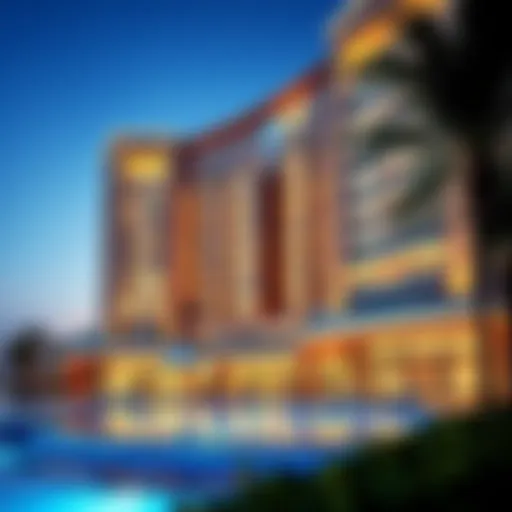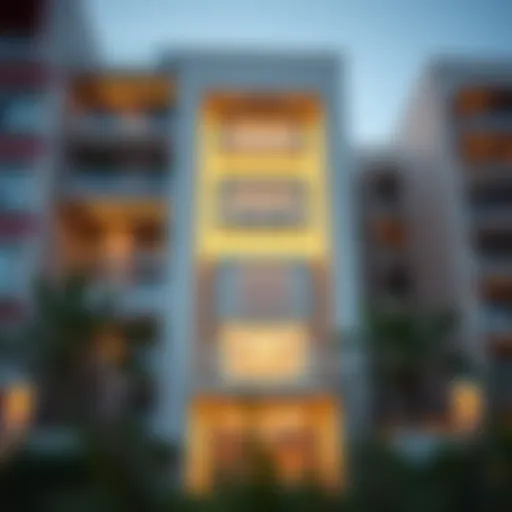Mastering Studio Flat Design: Optimize Space and Style
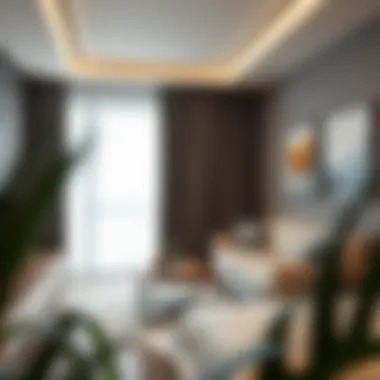

Intro
In today’s fast-paced world, the concept of living has taken on new dimensions, particularly for urban dwellers. Studio flats, often typified by their compact layouts and multifunctional spaces, represent not just a trend but a necessity for many. The charm of studio living lies in its ability to offer a personalized and unique environment while maximizing every inch of available area. This article serves as a guide for those looking to navigate the challenges of studio flat design, covering essential aspects of space utilization and aesthetic considerations.
More than just a roof over one’s head, a studio flat can become a canvas for creativity, allowing individuals to reflect their personalities through thoughtful design choices. From selecting functional furniture to embracing color palettes that evoke warmth and style, every decision plays a role in transforming a small space into a cozy sanctuary.
The following sections will delve deeper into critical elements influencing studio design, revealing strategies that enhance both livability and visual appeal. Whether you are a first-time buyer, an investor, or a real estate agent seeking insight into market trends, this exploration will arm you with valuable knowledge tailored to your needs.
Market Analysis
Current Trends in Property Prices
As the demand for urban living continues to rise, studio flats have increasingly become an attractive option for many. The latest data suggests a steady increase in property prices, often influenced by factors such as location, amenities, and overall market dynamics. Areas once considered less desirable are experiencing gentrification, leading to inflated prices that reflect their newfound appeal. Real estate websites often highlight that cities like San Francisco and New York City see a surge in demand for smaller living spaces as professionals seek proximity to workplaces while minimizing living costs.
Future Growth Projections
Looking ahead, the forecast for studio flats remains optimistic. With remote work becoming more common, many young adults prefer living in urban centers that offer access to the social and cultural vibrancy of city life.
- Market Insights: Analysts predict a continued appreciation of studio flats in desirable locales, particularly as more people opt for flexible living arrangements.
- Investment Potential: For investors, understanding the nuances of studio flats may reveal lucrative rental opportunities, especially in cities with heavy student populations or transient worker bases. The viability of short-term rentals also adds an intriguing facet to the market that savvy investors are keen to explore.
"The future of compact living is bright, as urban spaces evolve and new lifestyles emerge."
The studio flat market symbolizes a shift in societal values — one that prioritizes functionality and design over square footage. However, potential buyers and investors should remain cognizant of market fluctuations and local conditions, continuously adapting their strategies to seize opportunities as they arise.
Understanding Studio Flats
The design of studio flats has gained considerable attention in the real estate market, especially in urban centers where space is at a premium. Studio flats encapsulate the essence of minimalism while offering a unique blend of practicality and aesthetic appeal. Understanding studio flats serves as the foundation for grasping the intricacies of space utilization and design choices within these compact settings.
Definition and Purpose
A studio flat, fundamentally, is a small living space that combines multiple functionalities into a single room. Typically characterized by a combined living area, bedroom, and kitchen, it might have a separate bathroom but lacks distinct divisions for other spaces. This design aims to maximize every inch and meld living, sleeping, and cooking into a fluid, cohesive environment. As urban living becomes increasingly popular, the purpose of studio flats aligns with a lifestyle that favors cost-effectiveness and simplicity. For many, it’s not just about reducing housing costs; it’s about embracing a lifestyle where everything is accessible at arm's reach.
- Efficiency: Studio flats exemplify how less can be more, encouraging efficient living practices.
- Affordability: They often present a more approachable market entry for first-time buyers or renters.
- Flexibility: The open layout invites innovative, multi-functional uses of space, allowing residents to tailor it to their personal needs and tastes.
Historical Context
Historically, the concept of the studio flat can be traced back to the early 20th century when artists and bohemians sought small, affordable living spaces in urban environments. They needed a workspace that also accommodated their personal lives, which evolved into a distinct residential style. As cities expanded and urban populations surged, the demand for compact living spaces grew. Over the decades, studio flats evolved from simple artistic quarters to desirable residential options reflecting a broader lifestyle choice.
The Great Recession of 2008 played a pivotal role in changing housing markets, prompting a rise in smaller living spaces, as many sought to downsize or find affordable housing alternatives. Today, the historical context serves as a reminder of how societal shifts influence housing trends; studio flats stand as a testament to adaptability in urban living.
Demographics of Studio Flat Residents
The allure of studio flats attracts a variety of demographics, each with unique needs and desires. Typically, studio flats are popular among:
- Young Professionals: Many individuals in their 20s and 30s find that these living arrangements fit their fast-paced lifestyle, allowing them to invest more in experiences rather than housing.
- Students: With tighter budgets, students often embrace studio flats for their affordability near campuses.
- Retirees: As people downsize their living situation post-retirement, studio flats offer a comfortable alternative with fewer maintenance demands.
- Investors: Many investors are looking to studio flats for rental opportunities, given their potential for high returns due to consistent demand in urban areas.
In sum, understanding the diverse makeup of studio flat residents aids in grasping the importance of tailoring design and utility to fit varied lifestyles. As societal norms shift and urban spaces transform, studio flats will likely continue to adapt and resonate with a broad audience.
Key Elements of Studio Flat Design
In the world of studio flat design, the key elements serve as the foundation for creating functional and aesthetically pleasing spaces. This section delves into various strategies that not only enhance livability but also create a sense of style and individuality. Understanding these elements is crucial for anyone looking to navigate the challenges of compact living.
Functionality Over Aesthetics
In a studio flat, the balance between functionality and aesthetics is paramount. While it may be tempting to focus solely on visual appeal, without practicality, a space can quickly become unlivable. Functionality is about making the best use of limited square footage, ensuring that each piece of furniture and décor serves a purpose. For example, opting for a stylish ottoman that doubles as storage can be a game changer. Not just a pretty face, it minimizes clutter while adding a pop of style.
Emphasizing functionality encourages design choices that enhance the experience of the living environment. Residents learn to cherish minimalism and the freedom it brings. After all, who wouldn’t prefer a tidy space where everything has a place?
Maximizing Floor Space
Maximizing floor space is an art form in itself, and it involves strategic selections and arrangements of furniture and décor. Here, we explore various concepts that pave the way for more expansive living.
Smart Furniture Solutions
Smart furniture solutions highlight the brilliance of multifunctionality. Furniture that adapts to different needs is certainly a smart move when space is tight. For instance, a murphy bed can fold away during the day to free up room for activities, and it’s an excellent way of making every square foot count. Additionally, these pieces often come in sleek designs, meaning they’re aesthetically pleasing, too.
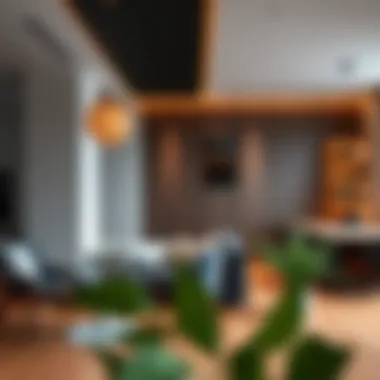

The unique feature here lies in their adaptability. While some smart furniture may come with a higher price tag, the investment pays off in versatility and space-saving capabilities, ultimately enhancing the overall living experience.
Vertical Storage Options
Vertical storage options are a clever strategy in small spaces where floor area is at a premium. Think about utilizing wall space with shelves that reach up toward the ceiling. This is where creativity meets efficiency.
Often touted for their ability to keep items off the floor and out of the way, such designs can be visually stunning when arranged artistically. This option promotes organized living while effortlessly adding character to the room. However, buyers should keep in mind that they may require some planning and commitment to maximizing their full potential.
Open-Concept Layouts
Open-concept layouts revolutionize the way we think about studio flats. By doing away with unnecessary walls, these designs create a sense of roominess that is especially valuable in compact residences. The flow of the space enhances social interaction and the interaction of light, which can make the area feel bigger and brighter.
A hallmark of this approach is its flexibility. Residents can rearrange furniture to suit their lifestyle, whether that means hosting friends or simply enjoying a quiet evening. However, it does necessitate careful planning; one must ensure that the defined zones do not clash visually or functionally.
Designing for Comfort and Style
Incorporating comfort alongside style transforms a mere living area into a personal sanctuary. Choosing soft textiles for sofas or layered rugs can invite warmth. Combining this with neutral palettes and tasteful accents creates an inviting atmosphere that reflects personal taste.
Finding that sweet spot between personal comfort and slick design is key to achieving a truly enriching environment. By prioritizing comfort alongside aesthetics, studio renters can make their space a true home.
"Effective design is less about aesthetics and more about creating a lifestyle."
The key elements discussed in this section are crucial in navigating the complexities of studio living, letting individuals tailor their spaces to complement their lifestyles while maximizing on both style and functionality.
Color Psychology in Studio Design
Color psychology is a powerful tool in studio flat design that can influence emotions, perceptions, and even behaviors. Within the limited confines of a studio flat, where space is at a premium, the selection and application of color becomes not just an aesthetic choice but a pivotal aspect of spatial utilization. Choosing the right colors can create an illusion of space, change the ambiance, and markedly affect your overall well-being.
The importance of color psychology is multifaceted. When residents of studio flats choose their color palette wisely, they can enhance both functionality and mood. Visual perception is closely tied to emotional responses, so a well-thought-out color scheme can make a small area feel more welcoming or vibrant. In essence, the hues that adorn the walls can transform a cramped space into a serene or energetic haven, depending on the desired effect.
Choosing a Color Palette
When it comes to selecting a color palette for a studio flat, thoughtfulness goes a long way. Clarity in color choices can guide the entire design process. Start by considering the amount of natural light in the apartment. A space with plenty of sunlight can usually handle more saturated colors without feeling overwhelming. Lighter shades like soft whites, pastels, or light grays can make a small area appear larger and airier. On the other hand, darker colors—like navy blue or forest green—tend to absorb light, potentially making space feel cozier but possibly smaller.
An effective way to approach color selection is by utilizing the 60-30-10 rule, a classic design guideline. This framework recommends allocating 60% of the space to a dominant color, which typically includes wall colors or large furniture pieces. Thirty percent should be a secondary color, often found in upholstery or curtains, and the remaining 10% is reserved for accents, such as decorative pillows or artwork.
- Neutral Tones: Starting with a neutral base can be a smart move, offering a backdrop that provides flexibility for future changes. Think off-whites, beiges, or light grays—these colors allow for easy adaptations, making it simple to switch out accent colors.
- Accent Colors: Once the base is set, choose one or two bold colors that resonate personally. This could mean using vibrant yellows or deep reds in accessories or artwork, adding character without overwhelming the space.
"Color is the keyboard, the eye is the harmonica, the soul is the piano with many strings." –Wassily Kandinsky
Influence of Light on Color Perception
Light plays a crucial role in how color is perceived. The same shade can look entirely different depending on the type of light illuminating it. Natural light varies throughout the day, shifting hues from a warm yellow in the morning to a cooler shade as evening approaches. Therefore, understanding how light interacts with your chosen color palette is imperative in studio flat design.
- Daylight vs. Artificial Light: Natural daylight tends to showcase colors beautifully, often making them appear more vibrant. In contrast, artificial lighting—like incandescent or fluorescent bulbs—can distort colors, making them seem yellower or blue-toned, respectively. For studio flats that rely heavily on artificial lighting, test how paints or fabrics appear under the specific light sources in your home before committing.
- Windows and Light Reflection: Consider the placement of windows and how sunlight might bounce off various surfaces. A well-placed mirror can not only brighten up a corner but also enhance the perceived depth of space. A strategically positioned mirror facing a window can amplify light levels and create an illusion of more space.
In summary, the interplay between color and light is significant in studio flat design. By understanding these aspects, occupants can create harmonious environments that resonate with their personal styles while maximizing the functional space available.
Furniture Selection for Studio Flats
Selecting the right furniture for a studio flat is a cornerstone in achieving an optimal living experience. Given the limited space of studio flats, careful consideration of each piece is crucial. Furniture should not only serve a distinct function but also contribute to the overall aesthetics of the space. The right selection can transform a cramped environment into a cozy retreat, striking a balance between form, functionality, and style.
This section will dive into various types of essential furniture and explore versatile options that effectively address the challenges of compact living. Every piece contributes to maximizing utility while maintaining aesthetic appeal. By choosing wisely, individuals can create an inviting atmosphere that reflects their personality while being practical.
Types of Essential Furniture
In the context of studio flats, essential furniture types include beds, seating, tables, and storage solutions. These items form the backbone of the living space. Below is a closer look at the aspects each type brings to studio design:
- Beds: Need to be comfortable yet compact. Murphy beds or lofted beds gain popularity in tight spaces.
- Seating: Sofas should be adaptable; consider shapes and configurations that can fit multiple uses.
- Tables: Dining tables can double as workspaces, while side tables can add functionality without taking up too much room.
- Storage Solutions: Options like shelves above furniture and built-in cabinetry can help keep clutter at bay while optimizing space.
Versatile Furniture Pieces
Versatile furniture plays a crucial role in studio flats, as it can accommodate varied needs without overwhelming the footprint. Here are popular choices:
Sofa Beds
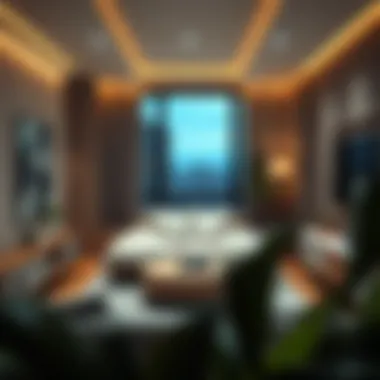

Sofa beds are an essential multifunctional piece. They provide a seating area by day and easily convert into a bed for overnight guests. The key characteristic of a quality sofa bed is its mechanism; look for designs that allow fluid transitions with minimal effort. This dual function makes sofa beds a beneficial choice for studio flats, especially when space is at a premium.
However, one must consider the comfort value. Not all sofa beds offer adequate support for sleeping. It's wise to try the piece out for comfort to avoid disappointing guests. A bonus: many sofa beds come with additional storage under the seat, further enhancing their utility.
Nesting Tables
Nesting tables are another clever solution for small spaces. They can be utilized separately when needed or stacked together to free up space. This flexibility is what makes them a popular choice—ideal for entertaining or when needing extra surface area for various tasks. The unique feature here is their ability to integrate seamlessly into a room. They can serve as side tables or make a statement as decorative pieces.
An advantage is that you get maximum surface area without committing to multiple pieces. However, some may argue that they can be tricky to position perfectly in a layout and risk becoming an afterthought in terms of decor.
Foldable Chairs
Foldable chairs exemplify the principle of convenience in small living arrangements. Their primary strength lies in their ability to be stored away when not in use, allowing for a more open floor plan. An important characteristic of foldable chairs is their light-weight design, which means they can be easily mobilized whenever required.
This benefit is welcomed in studio flats for hosting gatherings or simply needing extra seating from time to time. The downside may include comfort; some foldable chairs sacrifice cushiness for portability. Nevertheless, their space-saving design can contribute positively to a streamlined, organized atmosphere.
"The furniture you choose for your studio flat can either enhance or hinder your living experience."
In summary, the right furniture selection can significantly impact the functionality and appearance of studio flats. From sofa beds that optimize sleep space to nesting tables and foldable chairs for dynamic living, these elements all cater to specific needs, making compact life more comfortable. Understanding these dynamics can turn a studio flat into an inviting, efficient home.
Decorative Strategies for Small Spaces
When it comes to studio flat design, decorative strategies play a pivotal role in transforming a compact space into a cozy, inviting home. Given the limitations in square footage, it is essential to be creative with design choices, ensuring that both form and function blend seamlessly without compromising on style. Utilizing decorative elements allows residents to inject personality into their spaces while optimizing the existing layout for everyday living. Moreover, a well-thought-out decorating scheme can make a small area feel larger and more livable.
Art and Wall Decor
Art and wall decor hold a significant place in the overall aesthetic of studio flats. When walls are tastefully adorned, they can serve as powerful focal points. This is critical in small spaces, where each design decision must be impactful. Here are a few considerations:
- Personal Expression: Artwork reflects the individuality of the resident. Choosing pieces that resonate personally can forge a connection between the occupant and their space. Whether it's a vibrant abstract piece or a collection of evocative photographs, the right art can tell a story and evoke emotions.
- Patterns and Colors: Wall decor can introduce vibrant colors and patterns that enhance or complement the chosen color palette of the flat. For instance, a colorful tapestry can add warmth to a normally austere wall while providing visual interest without taking up valuable floor space.
- Framing and Arrangement: The manner in which artwork is hung can influence the perception of space. Creating a gallery wall with thoughtfully matched frames can draw the eye upward, making ceilings appear higher. Use of shelves to display smaller items and art can also free up floor space, enhancing the overall design.
"Art not only beautifies our surroundings but also elevates our experiences in small spaces."
Textiles and Soft Furnishings
Textiles and soft furnishings are instrumental in bringing warmth and comfort to studio flats. These elements not only serve a practical purpose but also introduce texture and depth to the design scheme. Here’s how:
- Layering Textiles: Incorporating various fabrics, such as cushions, throws, and rugs, adds a tactile quality to the space. Layering different textures can create a dynamic yet cohesive look, enhancing the visual interest without cluttering the floor.
- Cohesive Color Schemes: Just like wall decor, textiles contribute to the color scheme of a flat. Selecting cushions and throws that echo the dominant palette can tie the room together, making it feel more coordinated and purposeful.
- Functional Furnishings: Soft furnishings can serve double duty. For example, a stylish ottoman can function as both a coffee table and additional seating when required. Similarly, window treatments like light, airy curtains can make a room feel more open while lending an element of softness to hard surfaces.
Incorporating Technology in Studio Flat Design
In today’s fast-paced world, technology holds an essential place in our lives, and incorporating it into studio flat design is no exception. From smart home gadgets to effective home office setups, technology can transform a compact living space into a hub of ease and functionality. By integrating tech solutions, homeowners can optimize their environments to enhance both comfort and efficiency, making the most out of the limited square footage.
Smart Home Devices
Smart home devices have revolutionized how we interact with our living spaces. These gadgets offer convenience, control, and efficiency, catering perfectly to the unique demands of studio flats. Imagine adjusting your room’s lighting or temperature with a simple voice command or tap on your smartphone. Not only does this minimize the need for bulky controls and remotes, but it also streamlines the living experience.
Among popular smart home devices are:
- Smart Lighting: These lights can be programmed to change colors and brightness, setting the mood for any occasion while saving energy.
- Smart Thermostats: Maintaining an optimal temperature not only enhances comfort but also cuts down on utility costs.
- Smart Plugs: These allow users to control power to any device remotely, enabling energy-saving management of electronics and appliances.
Incorporating these devices can lead to a seamless integration of technology in daily routines. It thus contributes to a modern, efficient lifestyle in studio flats where every inch counts.
Home Office Integration
As more people are working from home, creating an effective home office within a studio flat is paramount. A well-thought-out work area is crucial for productivity, especially when working from a compact living space.
Integrating a home office might involve:
- Selected Furniture: Choosing a compact, multifunctional desk that fits snugly in a corner can turn a living space into an efficient workspace without overwhelming the area.
- Cable Management Solutions: A tangle of wires detracts from an organized appearance. Utilizing management systems can keep cords out of sight and maintain a clean look.
- Ergonomic Considerations: Investing in an adjustable chair or standing desk can improve comfort and productivity. It helps in maintaining good posture, countering hours spent working.
Integrating technology allows the home office to be functional while adhering to the stylistic principles of studio design, ensuring that the living space remains both professional and inviting.
"Embracing technology in studio flats not only amplifies space utilization but also elevates the living experience."
Through strategic incorporation of these technological elements, studio flats become far more manageable and enjoyable spaces to inhabit. The ability to create a seamless home-office experience and integrate smart living solutions leads to enhanced comfort and functionality, which is what modern urban living demands.
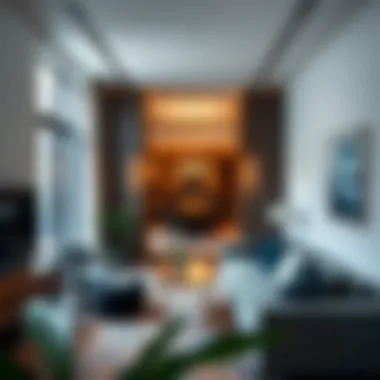

Sustainability in Studio Design
In today's world, where climate change and environmental degradation are pressing concerns, sustainable design has stepped into the spotlight. When it comes to studio flats, the need for eco-friendly choices is not only a moral obligation but also a practical one. Compact living environments where every square foot counts can benefit from sustainable elements, allowing residents to embrace a lifestyle that harmonizes with nature. Sustainability in studio design encompasses the use of eco-friendly materials, energy-efficient strategies, and innovative technologies that minimize waste and reduce the carbon footprint.
Eco-Friendly Materials
Selecting the right materials can make or break a studio flat’s sustainability profile. Eco-friendly materials, such as bamboo flooring or recycled metal accents, significantly reduce resource consumption and offer durability. Choosing low-VOC paints helps improve indoor air quality, making a studio flat a healthier place to live.
Some viable options for eco-friendly materials include:
- Reclaimed Wood: This not only adds character to the space but also lessens the demand for new lumber.
- Cork Flooring: A renewable resource that is naturally anti-microbial and great for sound insulation.
- Natural Fabrics: Cotton or linen blends for curtains and cushions contribute to a cozy environment while being biodegradable.
By leveraging such materials, designers can create spaces that are visually appealing and align with environmental consciousness. Future homeowners and tenants can find peace of mind knowing their residences are constructed with care for the planet.
Energy Efficiency Strategies
As the saying goes, "a penny saved is a penny earned," and this rings especially true in studio flats where space is at a premium. Energy efficiency strategies not only lower utility bills but also contribute to the overall sustainability narrative. Implementing smart solutions can vastly improve energy consumption.
Here are some strategies worth considering:
- LED Lighting: Using LED bulbs instead of traditional incandescent options can cut lighting energy usage significantly.
- Smart Thermostats: These devices adapt to the owner's schedule and preferences, boosting comfort while reducing excessive energy use.
- Good Insulation: Ensuring that the studio is properly insulated can prevent heat loss, keeping it cozy without cranking up the heat.
- Energy Star Appliances: Investing in appliances that meet Energy Star certification can lead to substantial savings on electric and water bills while supporting the sustainable cause.
Implementing these energy-efficient strategies not only benefits one's wallet but also contributes to a greener planet.
Case Studies of Successful Studio Designs
In the world of studio flat design, practical examples can often paint a far clearer picture than theoretical discussions. Case studies serve as a crucial bridge between concepts and real-life applications, showcasing how various design philosophies manifest in actual living spaces. They detail the choices made in a specific context, taking into account factors like user needs, aesthetic sensibilities, and spatial constraints. Successful studio designs can help inspire new ideas and methods for optimizing space, which is beneficial for real estate agents, investors, and homebuyers alike.
Urban Studio Flat Innovations
Urban environments present unique challenges and opportunities for studio flat design. Designs must often contend with smaller spaces while embracing the vibrant, dynamic feel of city life. One notable case is the The Shed, an innovative studio flat in East London. Featuring a modular design that allows the residents to configure their space to suit their daily needs, this studio exemplifies versatility. It incorporates a sliding partition that transforms the main area from living space into a home office with ease. This ingenuity showcases how utilizing multipurpose elements can turn minimalism into customization without sacrificing comfort.
Another impressive example comes from The Hive, a compact studio flat design in Tokyo. This urban residence marries modern aesthetics with high functionality; it seamlessly incorporates hidden storage solutions that preserve openness while providing clever organization. The designers employed innovative fixtures like foldable kitchen islands and wall-mounted desks, allowing the studio to adapt quickly to the user's lifestyle. This case reminds us that in urban settings, smart solutions can often be the lion’s share of success.
International Design Inspirations
Look beyond borders, and you will find a treasure trove of ideas to inspire studio flat designs. For instance, the Compact Living Unit in Sweden epitomizes Scandinavian design principles of simplicity and functionality. This studio harmoniously integrates wood finishes with neutral color palettes, promoting a sense of tranquility. It showcases how natural materials can foster a warm environment while executing the minimalistic function that characterizes many Scandinavian designs.
On the other side of the world, the Casa B in Brazil highlights vibrant colors and natural light, creating a playful atmosphere that contrasts with the more muted tones often found in other nations. This studio embraces an open layout designed to enhance natural ventilation, utilizing plants as decorative elements that breathe life into the space. Such international case studies not only emphasize the diverse ways spaces can be utilized but also how cultural elements can influence the design process.
In considering these successful studio designs worldwide, it's evident that integrating innovative solutions and local aesthetics can lead to spaces that are not only functional but also imbue character.
Future Trends in Studio Flat Design
The way we design our living spaces is constantly evolving, especially in the realm of studio flats where space is at a premium. Understanding the future trends in studio flat design is paramount, not only for homeowners but for real estate agents, investors, and developers. These trends help shape market demand and guide design strategies which can increase value and enhance livability. As urban living continues to grow, there are several key elements to consider that will define the next wave of studio apartment design.
Evolving Aesthetic Preferences
Aesthetics play a significant role in attracting potential buyers or renters to a studio flat. Over time, the preferences for certain styles have shifted. In previous years, many might have opted for minimalist designs characterized by monochrome palettes and sparse decorations. However, the pendulum is swinging towards more personalized spaces. Today, residents are increasingly drawn to eclectic combinations of vintage and contemporary styles that reflect individual identities.
Moreover, the integration of natural materials such as wood and stone is on the rise, catering to a demand for warmth and comfort. Color schemes are becoming bolder, with accents of bright colors against more neutral backgrounds. Such choices not only enhance the visual appeal but also create a positive emotional atmosphere, vital in small living spaces where every element counts.
One emerging concept is the use of biophilic design, which emphasizes a natural connection between inhabitants and nature. This approach often involves incorporating plants and green spaces or utilizing natural light effectively.
"The incorporation of plants in a well-designed studio flat can increase emotional well-being and decrease stress, making a compact space feel more expansive."
Homebuyers are also prioritizing sustainability in aesthetic choices. Designers are now tasked with not only creating beauty but also ensuring materials and methods are eco-conscious. The combination of these evolving preferences makes for a more vibrant and engaging living environment that speaks volumes about its occupant’s values and lifestyle.
Technological Integration Advances
As we leap further into the digital age, the incorporation of technology into studio flat designs is becoming a baseline expectation rather than an afterthought. Smart home technologies, including programmable thermostats, automated lighting systems, and integrated security systems, are increasingly being woven into the fabric of studio living.
However, the key lies in ensuring that this integration does not sacrifice design for functionality. Sleek, unobtrusive devices that blend seamlessly with the design aesthetic are favored. For example, there are now elegant smart assistants that can control lighting and temperature while being easy on the eyes.
Another important development is the rise of flexible workspaces within the home. As remote work becomes normalized, integrating a home office into a studio flat becomes crucial. Designers are innovating by creating multipurpose furniture that can transition from a living area to a workspace effortlessly. Foldable desks and extendable tables serve this purpose beautifully without consuming too much floor space.
With technology being a solution for many design challenges in compact living, it also opens up possibilities for improved energy efficiency. Advanced appliances that use less energy, smart water systems that optimize usage, and energy monitoring systems can all contribute to a more sustainable studio environment.
This combination of technological advances not only enhances the functionality of a studio flat but also affects its marketability. A technologically adept living space synonymous with convenience and modernity certainly stands out in the bustling real estate landscape.
In sum, the future of studio flat design lies in recognizing and adapting to the evolving aesthetic preferences of residents and the inevitable march of technological integration. As people continue to prioritize personalization and sustainability, a forward-thinking approach in design can lead to a win-win scenario for both homeowners and developers.









